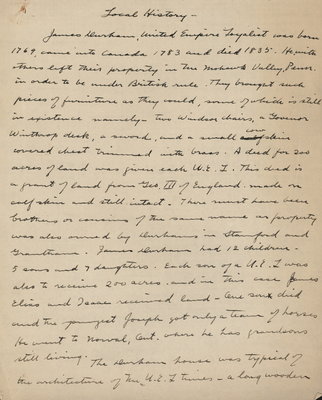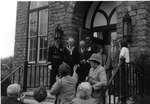QC00573-01
Local History -
James Durham, United Empire Loyalist was born 1769, came into Canada 1783 and died 1835. He with others left their property in the Mohawk Valley, Penn. in order to be under British rule. They brought such pieces of furniture as they could, some of which is still in existence namely - two window chairs, a Governor Winthrop desk, a sword, and a small cow skin covered chest trimmed with brass. A deed for 200 acres of land was given each U.E.L. This deed is a gran of land from Geo. III of England. made on calf skin and still intact. Those must have been brothers or cousins of the same name as property was also owned by Durhams in Stanford and Grantham. James Durham had 12 children - 5 sons and 7 daughters. Each son of a U.E.L. was also to receive 200 acres. and in this case James Elias and Isaac received land - one son died and the youngest Joseph got only a team of horses. He went to Norval, Ont. where he has grandsons still living.
The Durham house was typical of the architecture of the U.E.L. times - a long wooden
QC00574-02:
-2-
structure, nine windows and front door in the front - large central hall with rooms on either side, bedrooms above and a kitchen built on at the back. There were five fireplaces for heating. Later these were closed up and stoves used - one large stove in the hall extended through a hole in the wall, into the dining room. Here cordwood sticks were used. They also used straw under the carpets for warmth.
The house was situated near the pond on the site of the house owned by Howard Fisher opposite Glencairn. the property known as Glencairn originally belonged to the farm. It was sold to Hon. John Hamilton of Kingston who built the Glencairn house ^about 1834. This was afterwards bought by Hon. W. A Thomson father of Mrs R. C. Trimble.
Mary Durham, Mrs Isaac ? Sevazie was 5 yrs old at the time of the battle of Queenston Heights and when interviewed by the Globe said she remembered perfectly the officers making their home, headquarters for breakfast that morning. It was also said that Brock's body was carried in
QC00574-03:
-3-
there for a short while on the way to Niagara. I had always heard this in our own family but didn't take much notice until a Miss Durham from Woodstock, a great grand daughter of the Joseph Durham I mentioned before, visited us just lately and repeated the same story.
Mary Durham also remembered seeing an Indian kill one of her father's sheep in the upper orchard near his house. In the diary of Jas Durham II 1851 he speaks of replacing a peach orchard which his father had planted. So this would likely be an orchard planted about 1830 or even earlier. Jas. Durham also had quite a novel idea for those times in the shape of a bath house at the back of his house. He had bought the contrivance from an agent. It was on the principal of a shower bath which he indulged in even in the winter.
Wheat bought wonderful prices after the civil war and hence bought wealth to many U.E.L. farmers. Jas Durham II branched Ont, owned 400 acres in Garifapi Township, lots in St. Catharines and Queenston also the Col. Stevens property on River Road. He also owned 100 lanes of first Queenston Bridge in 1851. also in a bond, dated 1822 he + a over
QC00574-03verso
brother bought property in Stanford from Jas Kirley for which he paid 2000 bus. of wheat in three consecutive years.
Isabel M. Walsh
Local History of James Durham by Isabel Walsh
Description
- Creator
- Isabel M. Walsh, Author
- Media Type
- Text
- Notes
- This detailed history of James Durham may be the same document referenced in J. M. Crysler's letter to Isabel Walsh, dated 1936. Four handwritten pages measuring 25 x 20 cm.
A link to the letter is under the picture of the actual document.
From Armstrong family collection.
The Full Text may not be 100% accurate. - Date Of Event
- 1783
- Subject(s)
- Last Name(s)
-
Durham
- Local identifier
- QC00574
- Language of Item
- English
- Donor
- Huggins, Jean A. E. (1895-1989)
- Copyright Statement
- Copyright status unknown. Responsibility for determining the copyright status and any use rests exclusively with the user.
- Contact
- Niagara-on-the-Lake Public LibraryEmail:localhistory@notlpl.org
Website
Agency street/mail address:10 Anderson Lane P.O. Box 430
Niagara-on-the-Lake, ON L0S 1J0
905-468-2023 - Full Text




